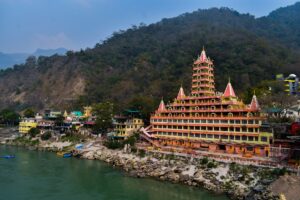
The moment you cross the suspension bridge at Lakshman Jhula, the world seems to slow down. The roar of the Ganges mingles with temple bells, chanting in the air, and the scent of incense drifting from riverside ashrams. This is Rishikesh—a place where every corner tells a story, and every step feels like a journey through both the mountains and your soul.
-
Morning at the Ghats
I wake early to the soft murmur of the river and join a small crowd at Triveni Ghat. Lamps flicker in the gentle breeze as the sun rises behind the Himalayan peaks. The Ganga Aarti begins, and for a moment, you forget the world outside. Time slows; the heart beats a little lighter.
-
Trekking Through Nature’s Canvas
After the serenity, adventure calls. The trail to Neelkanth Mahadev Temple winds through dense pine forests and rocky streams. Every turn offers a glimpse of cascading waterfalls, chirping birds, and the misty Himalayas. My boots crunch on the path as I marvel at the untouched beauty that seems almost unreal.
-
The Thrill of the Ganges
By afternoon, the river becomes a playground. I joined a team for white-water rafting. The cold spray hits my face as we navigate rapids, laughter echoing over the river. There’s a perfect balance here—peace and thrill, quiet and excitement—coexisting like nowhere else.
-
Hidden Gems and Ashrams
Evening leads me to quieter paths—the Beatles Ashram, covered in graffiti and nature reclaiming its walls, tells tales of music, peace, and creativity. Walking through Parmarth Niketan and Sivananda Ashram, I feel the calm seep deeper, grounding me.
-
Night Under the Stars
Camping by the river, the Milky Way stretches overhead. The Ganges whispers, the wind hums, and for the first time in days, the mind is still. Rishikesh isn’t just a destination—it’s a rhythm, a heartbeat, a feeling that stays with you long after the journey ends.
1. Triveni Ghat – Where the Ganges Whispers to the Soul
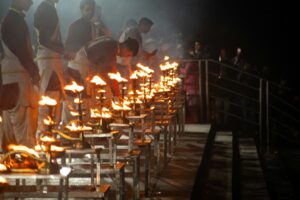
At the heart of Rishikesh lies Triveni Ghat, a sacred confluence where three holy rivers—Ganga, Yamuna, and the mythical Saraswati—meet. It’s not just a place, it’s an experience that wraps you in centuries of devotion and timeless legends. Mornings here are serene: sadhus seated in meditation, pilgrims performing rituals, and travelers soaking in the soft golden light as the river flows endlessly, carrying prayers downstream.
But it’s the evenings that turn this ghat into pure magic. As the sun dips behind the Himalayan foothills, bells ring, conch shells blow, and the Ganga Aarti begins. Priests move in perfect rhythm, holding massive oil lamps that paint glowing circles of light against the twilight sky. The chants rise, the flames sway, and hundreds of earthen diyas float upon the river like a moving galaxy. Whether you come for faith or for sheer wonder, this sacred ritual touches something deep within.
And if you look closely, you’ll notice tiny moments that linger—a child giggling as she sets her diya afloat, a traveler closing his eyes in silence, a group of musicians playing soft bhajans under the banyan tree nearby. Triveni Ghat is more than a tourist stop—it’s where you pause, breathe, and feel the pulse of Rishikesh itself.
- Things to do: Attend the evening Ganga Aarti, take an early-morning dip, shop for rudraksha beads and holy souvenirs from nearby stalls, or simply sit on the steps and watch life unfold.
- Best time to visit: October to March for pleasant weather, though the ghat is alive year-round.
- Entry fee: Free
2. Lakshman Jhula – Crossing Into the Heart of Rishikesh
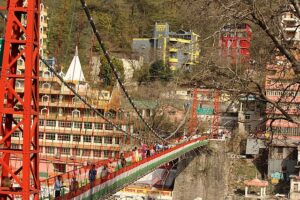
High above the emerald waters of the Ganga, the Lakshman Jhula stretches like a thread between two worlds—ancient myth and modern adventure. According to legend, this is where Lakshman, brother of Lord Rama, crossed the sacred river on nothing but a rope made of jute. Today, a graceful suspension bridge sways in its place, carrying pilgrims, travelers, and the curious from one bank to the other.
The first step onto the bridge feels ordinary… until you look down. The Ganga glitters far below, flowing with the same energy that has drawn sages here for centuries. Cows, bikes, and travelers shuffle past each other as the bridge gently rocks, reminding you that even in steel and wire, there’s still a touch of the old rope’s spirit. Look up, and you’ll see temple spires piercing the sky, colorful prayer flags fluttering, and cafes stacked along the banks where backpackers sip chai with the Himalayas watching silently.
- Things to do: Walk across at sunrise for peaceful views, visit nearby temples like Tera Manzil and Raghunathji, or stop in riverside cafes for authentic Garhwali food and global flavors.
- Best time to visit: October to March for crisp weather and clear views.
- Entry fee: Free (bridge crossing open to pedestrians and two-wheelers)
3. Ram Jhula – The Bridge Between Faith and Freedom
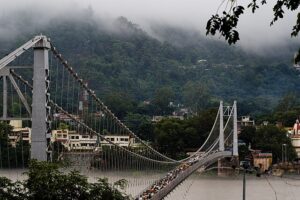
As you step onto Ram Jhula, the Ganges stretches beneath you like a ribbon of light, carrying centuries of stories downstream. The steel bridge hums gently with the footsteps of monks, travelers, and seekers from every corner of the world. Look to your left — ancient ashrams rise from the banks, their bells chiming softly in the breeze. Look to your right — markets spill over with incense, rudraksha beads, and the aroma of steaming chai. At sunset, the entire span glows as if blessed, and you feel suspended — not just over water, but between two worlds: the earthly bustle of Rishikesh and the spiritual calm that lingers in its air. Crossing Ram Jhula isn’t just a walk; it’s an initiation into the heartbeat of the Himalayas.
Things to Do at Ram Jhula
- Take an evening stroll and watch the Ganga Aarti from the bridge.
- Visit the nearby Swarg Ashram and Gita Bhawan for a spiritual retreat.
- Enjoy a riverside meal at famous cafes overlooking the Ganga.
Best Time to Visit
- October to March offers cool, pleasant weather, perfect for exploring.
- Early mornings and evenings are magical, with fewer crowds and glowing skies.
Entry Fee
- No entry fee. The bridge is open to pedestrians and two-wheelers.
4. Parmarth Niketan – Where the Ganga Finds Its Voice
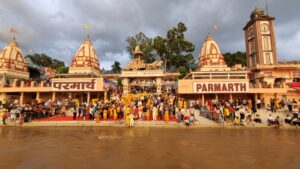
As you wander through its expansive grounds, you’ll notice temples, lush gardens, and peaceful pathways where sadhus and visitors walk in quiet contemplation. The air is fragrant with incense and flowers, and the sounds of bells and chants form a melodic backdrop that seems to sync perfectly with the flowing Ganga.
The evening Ganga Aarti is the ashram’s crowning jewel — hundreds of lamps float on the river, their golden reflections mingling with the chanting of priests and the gentle ripples of the water. It’s not just a ritual; it’s an experience that awakens the senses and soothes the soul, making visitors feel as if they are part of something eternal.
Parmarth Niketan also offers daily yoga and meditation sessions, spiritual workshops, and volunteer opportunities. Here, visitors can learn holistic wellness practices, chant mantras, or simply sit by the river to absorb the calm energy that seems to linger in every corner.
- Things to Do: Attend the Ganga Aarti, participate in yoga and meditation, explore the gardens and temples, take part in workshops, or volunteer.
- Best Time to Visit: October to March for pleasant weather and serene river views.
- Entry Fee: Free (optional donations for lamps or rituals
5. Neelkanth Mahadev Temple – Where the Divine Drank Poison
Tucked deep in the lush forests of the Garhwal Himalayas, Neelkanth Mahadev Temple stands as a sacred beacon for devotees and travelers alike. The temple is perched about 32 km from Rishikesh, surrounded by roaring waterfalls, dense pine and oak forests, and winding trails that invite you into nature’s embrace.
Legend has it that during the Samudra Manthan (churning of the ocean), Lord Shiva drank the deadly poison Halahala to save the universe, and his throat turned blue — giving him the name Neelkanth. Every stone, every corner of the temple, echoes this story, making it not just a spiritual destination but a living testament to sacrifice, devotion, and divine power.
The journey to the temple is as enchanting as the shrine itself. Trekking paths meander alongside waterfalls, and monkeys playfully watch travelers as they ascend. The scent of pine fills the air, and the serene surroundings create a natural meditation path before you even reach the temple.
At the temple, the main Shiva lingam exudes energy, and you can witness daily rituals, prayers, and offerings performed by priests. Devotees often take a holy dip in the nearby Ganga-fed stream, believed to purify the body and soul. Visiting Neelkanth Mahadev is more than a pilgrimage — it’s a spiritual journey that connects you to nature, legend, and divine energy all at once.
Things to Do
- Trek through scenic forest trails leading to the temple.
- Witness or participate in daily Shiva rituals and offerings.
- Enjoy nature photography of waterfalls, forests, and Himalayan views
Best Time to Visit
- March to June and September to November for pleasant trekking conditions and clear skies.
Entry Fee
- Free entry (optional donations for rituals).
6. Bharat Mandir – Where Time Bows to the Divine
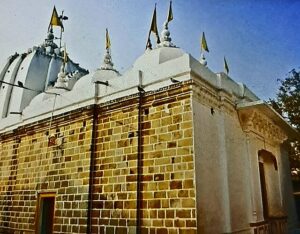
Long before Rishikesh became a traveler’s haven for yoga and rafting, it was a land whispered about in sacred texts. In its heart stands Bharat Mandir, an ancient shrine dating back to the 8th century, believed to have been sanctified by Adi Shankaracharya himself. Dedicated to Lord Vishnu, the temple holds within its sanctum a Saligram idol — a single black stone that radiates an unspoken strength.
The temple isn’t just stone and mortar; it feels alive, breathing with centuries of chants and pilgrim footsteps. On Basant Panchami, the idol is ceremoniously bathed and carried in a grand procession to the banks of the Ganges, recreating an age-old tradition where the river bows to the deity.
Outside the sanctum, the fragrance of incense lingers in narrow alleys, mingling with the calls of temple bells and the murmur of pilgrims. The courtyard invites stillness, making you forget that modern Rishikesh lies just beyond its gates. It’s not just a place to worship; it’s a place to pause, listen, and feel the weight of history settle gently on your shoulders.
Things to Do
- Offer prayers and experience the ancient sanctity of the Vishnu idol.
- Visit during Basant Panchami to witness the traditional procession to the Ganges.
- Explore the small museum displaying historical artifacts related to the temple.
Best Time to Visit
- October to March for pleasant weather.
- Basant Panchami festival (Jan/Feb) for the full cultural and spiritual experience.
Entry Fee
- No entry fee (donations welcome).
7. Patna Waterfall – Nature’s Hidden Emerald in Rishikesh
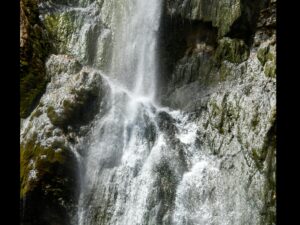
Tucked away in the lush green forests near Rishikesh, Patna Waterfall is a secret whispered by nature itself. The sound of rushing water blends with the chirping of birds, as the cool mist brushes against your face. The trail leading to the waterfall is as enchanting as the destination — a short hike through Rajaji National Park, where sunlight dances through the canopy and butterflies accompany your journey. At the end of the path, the crystalline cascade greets you, flowing down limestone rocks into a serene pool.
Named after the nearby village of Patna, this waterfall is a perfect retreat for those who crave peace, natural beauty, and a hint of adventure. It’s not commercialized — no loud crowds, no souvenir shops — just pure Himalayan wilderness.
Things to Do
- Photography of the emerald water and surrounding flora.
- Picnic by the falls — though remember to leave no litter.
- Explore the nearby caves around the waterfall area.
Best Time to Visit
- Monsoon (July to September): The waterfall is at its fullest and most majestic.
- Winter and Spring (October to March): Pleasant weather for trekking.
- Avoid peak summer afternoons as the trail can get hot.
Entry Fee
- No entry fee.
- A small forest entry permit may be charged if you’re going through Rajaji National Park routes.
8. Gurudwara Sri Hemkund Sahib – Where Faith Touches the Sky

High in the lap of the Himalayas, at an altitude of over 4,000 meters, lies Gurudwara Sri Hemkund Sahib — a place where devotion meets divinity, and the mountains seem to bow in reverence. The trek to Hemkund is not just a journey of the body, but of the soul. Pilgrims ascend through misty trails, past wildflowers and waterfalls, breathing thin air yet finding strength in their unwavering faith.
At the summit, a serene glacial lake mirrors the snow-clad peaks, and by its side stands the sacred gurudwara, shining like a beacon of peace. Legend says Guru Gobind Singh, the tenth Sikh Guru, meditated here in his previous incarnation. The stillness of the water and the crisp mountain wind seem to carry echoes of his divine presence.
Hemkund Sahib is open only a few months a year due to heavy snowfall, making every visit a fleeting, precious gift. Whether you go for faith, adventure, or the sheer beauty of nature, you leave with your heart humbled and your spirit renewed.
Things to Do.
- Trek the 6 km trail from Ghangaria — a challenging but rewarding climb.
- Visit the Gurudwara and take part in prayers and langar (community meal).
- Explore Hemkund Lake — crystal clear and surrounded by seven peaks.
- Combine with the Valley of Flowers trek, just a short diversion away.
- Photography of wildflowers and landscapes, especially during bloom season.
Best Time to Visit
- Mid-June to Early October — the gurudwara is open only in these months.
- July and August — best to see the Valley of Flowers nearby in full bloom.
- Winters are inaccessible due to heavy snow.
Entry Fee
- No entry fee.
- Donations at the gurudwara are voluntary. Also read this-https://thetripstairs.com/top-10-must-visit-places-in-chopta-uttarakhand/
FAQs – Frequently Asked Questions about Rishikesh
- Where is Rishikesh located?
Rishikesh is a spiritual town in the Dehradun district of Uttarakhand, India. It lies on the banks of the River Ganga, about 240 km from Delhi and 25 km from Haridwar. - Why is Rishikesh famous?
Rishikesh is known as the “Yoga Capital of the World” and a gateway to the Himalayas. It’s famous for yoga, meditation, spiritual retreats, the Ganga Aarti, adventure sports like river rafting, and iconic landmarks like Laxman Jhula and Ram Jhula. - What is the best time to visit Rishikesh?
The best time to visit is between September and April, when the weather is pleasant for sightseeing, rafting, and outdoor activities. The monsoon (July–August) is not ideal for rafting, but it is beautiful for nature lovers. - How to reach Rishikesh?
- By Air: The nearest airport is Jolly Grant Airport (Dehradun), 21 km away.
- By Train: The nearest railway station is Haridwar (25 km).
- By Road: Rishikesh is well-connected by buses and taxis from Delhi, Haridwar, and Dehradun.
- Is Rishikesh safe for solo travelers?
Yes, Rishikesh is generally safe for solo and women travelers. However, like any tourist destination, it’s advisable to be cautious, avoid late-night lonely walks, and choose safe accommodations. - What are the top things to do in Rishikesh?
- Attend the Ganga Aarti at Triveni Ghat
- Visit Laxman Jhula & Ram Jhula
- Experience river rafting, bungee jumping, and trekking
- Join yoga and meditation retreats
Explore The Beatles Ashram (Chaurasi Kutia)
